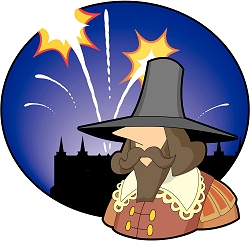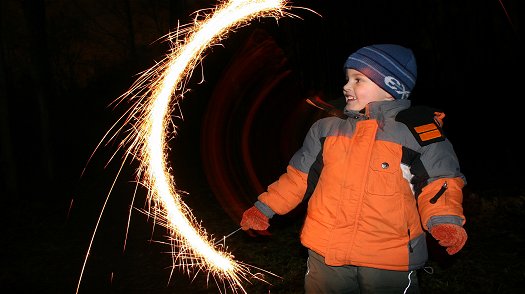November 5th - Bonfire Night....
"Remember, remember, the fifth of November. Gunpowder treason and plot. We see no reason, why gunpowder treason, should ever be forgot."
So what is Bonfire Night in the UK all about? this is the story of Guy Fawkes and his plot to blow up King James 1 and his government.
The Gunpowder Plot....

On the death of Elizabeth 1 in 1603 the English Crown went to the next descendant of Henry VII. This was the Scottish King James VI who had already been the King of Scotland for 36 years, having been crowned when he was only 1 year old. He became James 1 of England and believed in 'the divine right of kings' and took little notice of Members of Parliament. He found a country divided by religion and although he managed to make enemies of both Protestants and Catholics he was looked upon as a Protestant king and persecution of Catholics continued.
A plot to kill him was devised only two years after James was crowned King of England which became known as 'The Gunpowder Plot'. Members of this group of Catholics included Robert Catesby, John Wright, Thomas Percy and Thomas Winter although the best remembered of the group is Guy Fawkes - Born in York in 1570 and educated there as a Protestant. After his father's death he converted to Roman Catholicism. In 1593 he left England to become a 'soldier of fortune' and joined the Spanish army in Flanders. He began to use the Spanish form of his name Guido Fawkes. Fawkes was approached in Flanders by Thomas Winter and crossed to England in 1604 to join the group.
Guy Fawkes Lights The Fuse
Initially a house was rented next door to the Houses of Parliament and it was proposed to dig a tunnel from the cellar to the House of Lords. There, barrels of gunpowder would be piled and when the King and all the Members of Parliament were assembled for the opening of Parliament on February 7th 1605 the barrels would be ignited. Guy Fawkes was set the task of lighting the fuse and escaping as best he could. Digging began but progress was slow and by December 1604 the House of Lords had not been reached. It was then learnt that the Opening had been postponed until 3rd October. A cellar directly under the House of Lords was then taken by Guy Fawkes, under the name of Johnson, and he was instilled as the servant of the new owner. Small barrels of gunpowder were ferried across the River Thames by night, taken one by one into the cellar and covered with firewood. Elaborate plans had been made by Catesby and the others as to what was to happen following the death of King James. The Princess Elizabeth, a daughter of King James, was at once to be proclaimed Queen. Fighting was anticipated before James' followers would agree to her accession and in preparation arms and ammunition were stored in various parts of the country.
At this point a further member was brought into the plot, Francis Tresham. Money was needed to buy arms and Tresham promised to give £2,000. The group returned to London in September ready for the opening of Parliament but again it was postponed, this time to November 5th. During this further period of waiting one of the plotters, probably Francis Tresham, wrote to Lord Mounteagle (his brother-in-law) with a warning not to be at the ceremony as...'they shall receive a terrible blow ... and yet shall not see who hurts them'. Guy Fawkes had been left in London again while the others rode to positions around the country to be ready to 'rouse their fellow Catholics after the death of the King. He was to spend the day prior to the ceremony in the cellar. A special slow-burning fuse had been prepared and placed in position. Suddenly there was a knock on the door and outside he found Lord Mounteagle and the Lord Chancellor who asked who he was and what he was doing. He replied he was a servant of Thomas Percy (the cellar had been hired in his name). A quick look in the cellar obviously revealed nothing but stacks of firewood ready for winter and the two men went away.
Guy Fawkes, after contact with Thomas Percy to report the incident, returned calmly to the cellar. However, his sense of relief was short-lived for later that night a magistrate and a file of soldiers suddenly appeared and Guy Fawkes was overpowered. A more thorough search of the cellar soon revealed the thirty or more barrels of gunpowder and Fawkes was taken away. The others could not be warned of the failure of the plot. King James himself questioned Guy Fawkes and although he admitted to plotting to blow up the Houses of Parliament he refused to give the names of other conspirators. Several of the group had joined together at Holbeach and all realised there was no support for them - no-one would take up arms with them and risk their lives in a cause that was obviously doomed to failure. Eventually the house they were staying in was surrounded by soldiers and armed men. Catesby was killed and the others taken prisoner when they were too weak or badly wounded to fight any longer. Some were hung on January 30th 1606, but Fawkes and others were hung on the 31st except for Francis Tresham. He was sent to the Tower of London but not harshly treated. When he died shortly afterwards poison was suspected but never proved. Part of the ceremony of the Opening of Parliament each year includes a search of the buildings by the Yeoman of the Guards in their tudor uniforms, armed with pikes.
Apple Bobbing
One of the oldest traditional Bonfire Night games is bobbing for apples, and this can be a useful distraction while the food is prepared. Set out a dish-washing bowl full of water and float several apples. Children take turns to catch an apple in their teeth – no hands are allowed. The game is harder if stalks are removed.)
Don't Forget Garden Wildlife On Bonfire Night
With all the excitement of bonfire night don’t forget about the wildlife in your garden. Make sure the bonfire isn’t set up too far in advance, as hedgehogs and other small mammals will be looking for somewhere to hibernate at this time, and may find a pile of leaves and wood enticing also place fireworks away from trees and hedges where birds may be roosting.
Bonfire Night Party Food
So we already know a bonfire and fireworks are going to play a big role in our party but what else can we add to make the party more interesting? Consider taking your own flasks with warming drinks to heat up cold bodies! As well as drinks pack a bag of seasonal treats - toffee apples and slabs of delicious Parkin (a traditional cake to celebrate November 5th) are yummy and easily portable. Other seasonal delicacies include roast chest nuts and bonfire toffee.
Penny For The Guy
Traditionally in the UK children make Guys made to look like Guy Fawkes by stuffing old clothes with straw and newspaper. These are then be touted around local streets to collect money to buy fireworks for Bonfire Night.

The Firework Code....
Wear earplugs when lighting fireworks. Without them, you can be left feeling dizzy, deaf and disorientated.
When buying fireworks, make sure they comply with BS 7114 and are clearly marked for their intended use "Indoor, Garden or Display."
Keep fireworks in a sealed box or tin. Use them one at a time, replacing the lid immediately.
Never put fireworks in your pocket.
Read the instructions carefully, using a torch or hand lamp. Never use a naked flame.
Light fireworks at arms length using a taper or a firework lighter.
Stand well back and never return to a firework after it has been lit, it could explode in your face.
Ensure that all children with fireworks are well supervised.
Never throw fireworks.
Keep all pets and animals indoors.
Take care of sparklers, wear gloves to hold them and dispose of sparklers in a bucket of water as soon as they are finished.
Things you never knew about fireworks....
1. The first fireworks were probably made in China,
around 2,000 years ago.
2. Over 130 million fireworks were sold in Britain in 1995.
3. In the Far East, fireworks have been used at religious ceremonies
for centuries.
4. Last year over 900 people required hospital treatment from accidents
involving fireworks.
5. The word for firework in Japanese, 'hanabi', means 'fire-flower'.
6. Italy and France were the first European countries to have fireworks,
in the 1300s.
7. At family back-garden displays, sparklers cause more injuries
than air-bombs, bangers, rockets and roman candles combined.
8. The first recorded use of fireworks in Britain was at the wedding
of Henry VII in 1486.
9. Half of all firework accidents happen to children under the age
fo 16.
10. The first fireworks recorded in America were set off by an Englishman,
Captain John Smith, famous in the story of Pocahontas.
11. Coloured fireworks didn't exist until the 1800s.
12. Three sparklers burning together generate the same heat as a
blow-torch.
13. The world's largest single firework was set off at a festival
in Japan in 1988. The shell weighed over half a tonne and the burst
was over a kilometre across.
14. Hands and eyes are most at risk in firework accidents.
15. A firecracker display in Malaysia in 1988 used over 3 million
crackers, measured almost 6 kilometres and burned for over 9 hours
- the longest display on record.
16. Most firework accidents are caused at family back-garden displays
closely followed by incidents in the street.
17. Throwing a firework in a street or public place is a criminal
offence, with a maximum fine of 5000.
Children & Sparklers....

Never give sparklers to the under 5s - they will not understand how to use them safely. Always supervise children using sparklers. Give children gloves to wear when holding sparklers.
Avoid dressing children in loose or flowing clothes - they may catch light. Show children how to hold sparklers - away from their body and at arm's length. Teach children not to wave sparklers near anyone else or run while holding them.
In an Emergency....
Cool the burn or scald with cold water for at least 10 minutes. Cut around material sticking to the skin - don't pull it off. Don't touch the burn or burst any blisters. Cover the burn with clean, non-fluffy material - cling film is ideal - to prevent infection. If clothing catches fire, get the person to stop, drop to the floor and roll them in heavy material like a curtain. Get advice from your doctor or accident and emergency department at your local hospital. If you are having a bonfire, make sure that the fire is away from fences, garden sheds, and properties.
Never let your children near the fire and try to cordon off the area. Never light the fire using flammable liquids such as petrol and paraffin. Consider the wind direction and other properties nearby such as thatched roofs etc. Keep a bucket of water or a garden hose handy. Never leave a bonfire unattended. Make sure there are no aerosols that may explode in the fire. Make sure the fire is extinguished before going back indoors. Try to go to an organised display in your area.
Remember, have a safe and happy night.
